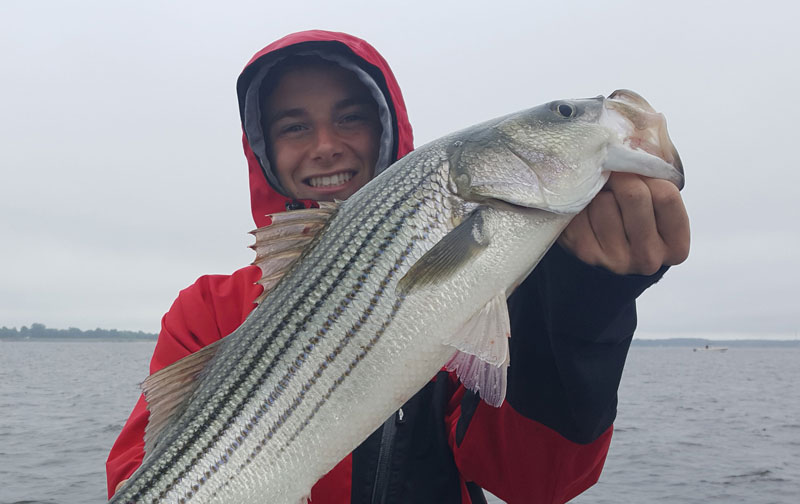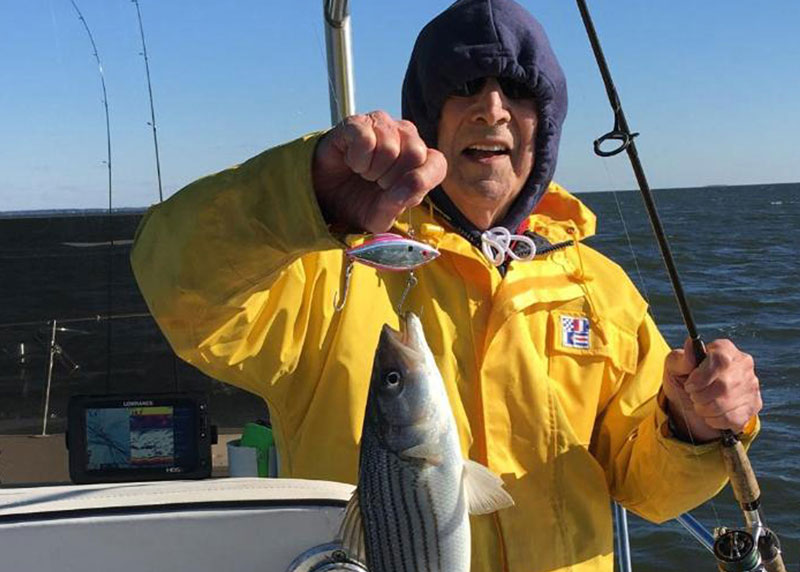What’s worse than waking up to discover a 20-knot breeze when you’re bound and determined to try some Chesapeake Bay fishing? Not having a backup plan. Push your luck and head for open waters on a relatively small boat and there’s a good chance you’re in for little more than a pounding and a soaking. But if you’re a trailer-boater ready to execute a Plan B you still have a great shot at enjoying a fun and productive day.

Deciding Where to Fish
Before we dig into the how-to let’s take a moment to consider the where-to. Much of the time we have a west wind in these parts, but thanks to the epically erratic nature of the Chesapeake’s shorelines, no matter which direction the wind is blowing you can almost always find a tributary or portion of a tributary that will be sheltered from the wind to some degree. If you haven’t already tried it, pull up Fishweather.com and click on the Forecast Map. You’ll see a map of the Bay with arrows indicating wind direction and speed in three-hour increments, from current time to over a week in the future. Like all weather predictions it isn’t perfect, but a day or two out it generally proves pretty accurate. And with a glance you can see what sections of which tributaries will be last exposed to the gusts de jure.
Sure, different tribs will be holding different numbers of fish every season and this may factor into your decision regarding a destination. On the other hand, if your boat is moored in a tributary you’re more or less stuck in your home waters. Either way, sometimes it’s utterly shocking how good the fishing for striped bass can be in tributaries ranging from the Elk River clear down to the Elizabeth. So before you pull the plug on a trip merely because the atmosphere is gushing this way or that, take a gander at that map and look for a lee.
Tributary Trolling Temptations
Truth be told you can tow just about any of the usual open-Bay offerings in the tributaries just as long as the lures are sized for 20-something rockfish. However, I’ve found two things to be particularly productive when meandering up and down a tributary channel: one-ounce chrome Rat-L-Traps, and half-ounce yellow or white feather jigs dressed with a twister tail and run eight to 12 feet behind a triple-swivel with a two- to three-foot dropper rig.
The Rat-L-Traps are set-and-forget easy. Clip ‘em on the end of two of your light lines, make a long cast off either side of the boat, sit them in aft holders, and ignore them until they get a strike or you notice that a rod tip isn’t vibrating (which means the lure isn’t swimming properly, usually the result of tangling or snagging something). A 6’6” or 7’0” spinning or casting rod with 20-pound braid and 30-pound fluoro leader works great for these lines.
The feather jigs, which essentially amount to mini bottom-bouncing rigs, require a bit more work and slightly heavier gear. These catch best when an angler holds the rod (standing forward of the Rat-L-Trap lines with the rod held out to the side of the boat) and jigs it as you troll, sweeping the rod forward then dropping the tip back until he or she feels the weight tap down on the bottom and the end of the drop-back. As depth changes, the angler should reel in or let out line as necessary to maintain contact with the bottom without dredging it. Just how much weight is ideal depends on depth, speed, current, and other factors, but as an example to work from, four ounces is usually enough in 15 or so feet of water when trolling at a couple mph. Naturally, with this much weight involved you’ll need a rod with a bit more backbone than the ones running the Rat-L-Traps.

Savvy captains with a good crew will keep an eye on the meter, and call out a heads-up when there are significant changes in depth as the boat passes over a drop-off. Then, the angler will be prepared to drop back or reel up as necessary. Anglers should be prepared for strikes to come most often just as or before the weight taps down. And yes, this rig will catch fish if you sit it in a rodholder — but it’ll catch half as many as an actively jigged rod will.
Channel Edges
In most of the tributaries your best bet is going to be trolling along the channel edges, zig-zagging a bit so your lures pass across the drop-offs. Areas which have oyster bars definitely should get some extra attention, as should underwater points that jut out into the channels. The mouth of the trib is often, but certainly not always, a hot zone.
Take a good look at a chart prior to hitting any specific trib so you can mentally map out a trolling pattern going up and down the edges. As you do so, keep that wind direction in mind. While staying inside protected water will keep you from getting beaten up and wet, blustery days can still make fishing tough since the wind catches your lines. If you troll across the breeze and it’s really gusty, the Rat-L-Trap lines can get blown so far off course they may tangle. So, whenever possible spend most of your time with either the bow or the stern pointing into the wind.
It’s depressing when gusty winds ruin your fishing plans. But it’s even more depressing to sit at home on the couch, when you know darn well you could be catching fish. Give trib-trolling a try, and we’re betting that the next time 20 knots are in the forecast your Plan B will already be firmly in place.
We’ve covered some more precise tributary scenarios in the past, so for more on tributary trolling specific to kayak fishing, seasonality, and light tackle only, check out these other articles.